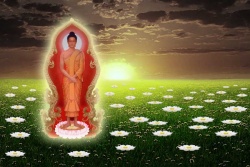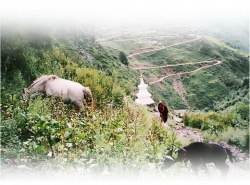Ngawang Trinle
Ngawang Trinle (ngag dbang 'phrin las) was born in the Chozar (chos zar) region of Tsang in 1657. At the age of sixteen he took ordination from his paternal uncle, Lodro Namgyel (blo gros rnam rgyal, 1618-1683), a disciple of Tāranātha Kunga Nyingpo (tA ra nA tha kun dga' snying po, 1575-1635).
From an early age he studied with Chalung Dorje Draktsen (cha lung rdo rje drag btsan) from Chalung Monastery. By the time he was twenty years old, he had trained extensively in the so-called middle lineage of Vinaya as well as the Abhidharmakośa, Mādhyamaka and Prajñāpāramitā as well as within the Jonang Kālacakra tradition, having received profound instructions on the six-fold vajrayoga from his uncle Lodro Namgyel. He completed his exams in the presence of the Fifth Dalai Lama, Ngawang Lobzang Gyatso (ta la'i bla ma 05 ngag dbang blo bzang rgya mtsho, 1617-1682).
He was appointed to serve as a representative of a lama at Dzamtang in Amdo, but his parents discouraged it, and he decided not to go. Then, at the age of twenty-four, with the death of his uncle and the forcible conversion of Tāranātha's monastery, Takten Damcho Ling (rtag brtan dam chos gling), from the Jonang to the Geluk tradition, with the new name of Ganden Puntsok Ling (dga' ldan phun tshogs gling), his place of residence became uncertain. At this time, Ngawang Trinle began to wander, giving teachings at various Jonang monasteries. For six years, he practiced the six-fold vajrayoga at Amitu (a mi tu) hermitage and spent four years teaching at Puntsok Lhundrub (phun tshogs lhun 'grub) Monastery. He also conferred empowerments and gave instructions from the Jonang tradition to the nephews of Drokge Kunga Pelzang ('brog dge kun dga' dpal bzang, 1629-1686). He exchanged teachings with Rigdzin Choyang Dorje (rig 'dzin chos dbyangs rdo rje, d.u), receiving teachings on the northern terma tradition and giving numerous Jonang instructions.
In 1707, he returned to the seat of Chalung Dorje Drak where he established a school for instruction on the six-fold vajrayoga practices of the Jonang Kālacakra. Having lived for years as a hermit, he became renowned throughout U and Tsang for his nonsectarian approach. He was well known within the circles of the Fifth Dalai Lama and the Geluk for the Shangpa Kagyu and Jonang initiations that he transferred to Mok Chok Tulku (rmog cog sprul sku, d.u.), and for the Sakya and Drukpa Kagyu teachings that he received from Sanggye Zangpo (sangs rgyas bzang po).
By 1700 he had established Jonang teachings as part of the curriculum at both the Geluk monastic universities of Drepung ('bras spung) and Ganden (dga' ldan). He had also become the teacher of numerous prominent Jonang scholars including Choje Kunzang Wangpo (chos rje kun bzang dbang po, d.u.).
He traveled to Dzamtang in 1719 where he was celebrated as an accomplished master for the legacy that had spread from his many disciples. He then proceeded down to Sikkim and along the way visited the seat of Tāranātha's close disciple, Kunga Rinchen Gyatso (kun dga' rin chen rgya mtsho, d.u.).
Late in 1714, by invitation from Lhazang Khan (d. 1717), chief of the Khoshut tribe of the Oirat Mongols who ruled Tibet, and by command of the Fifth Paṇchen Lama Lobzang Yeshe (paN chen blo bzang ye shes, 1663-1737), Ngawang Trinle set out to Mongolia. After a yearlong program of giving extensive Buddhist teachings in Mongolia, he planned to return to his home in U-Tsang. However, due to the massacre of Lhazang Khan by the Zunghar Army in 1717, U and Tsang were off limits and Ngawang Trinle was forced by circumstance to remain in Mongolia where he continued teaching and established several monastic colleges. After a year, he returned from Mongolia to his home in Tibet. He stayed at Tashilhunpo where he gave Jonang transmissions and initiations to the chief of Mongolia and the ruler of Tibet, Tsetan Dorje (tshe brtan rdo rje, d.u.).
Among his numerous disciples are his nephew Ngawang Namgyel (ngag dbang rnam rgyal, d.u.), Je Kunzang Wangpo (rje kun bzang dbang po, d.u.), Khenchen Chakpa Chopel (mkhan chen chags pa chos 'phel, d.u.), Drogke Chokyong Dondrub ('drog dge chos skyong don 'drub, d.u.) and others.
Ngawang Trinle died in 1723.
Sources
Ngag dbang blo gros grags pa. 1992. Jo nang chos 'byung zla ba'i sgron me. Beijing: Krung go'i bod rig pa dpe skrun khang, p. 69 and p. 280.
Nga dbang rnam rgyal. Rje ngag dbang ‘phrin las kyi rnam thar nyung ngu rnam gsal. Unpublished manuscript. Acquired by the Jonang Foundation.
Tsering Namgyal and Michael Sheehy
March 2013

